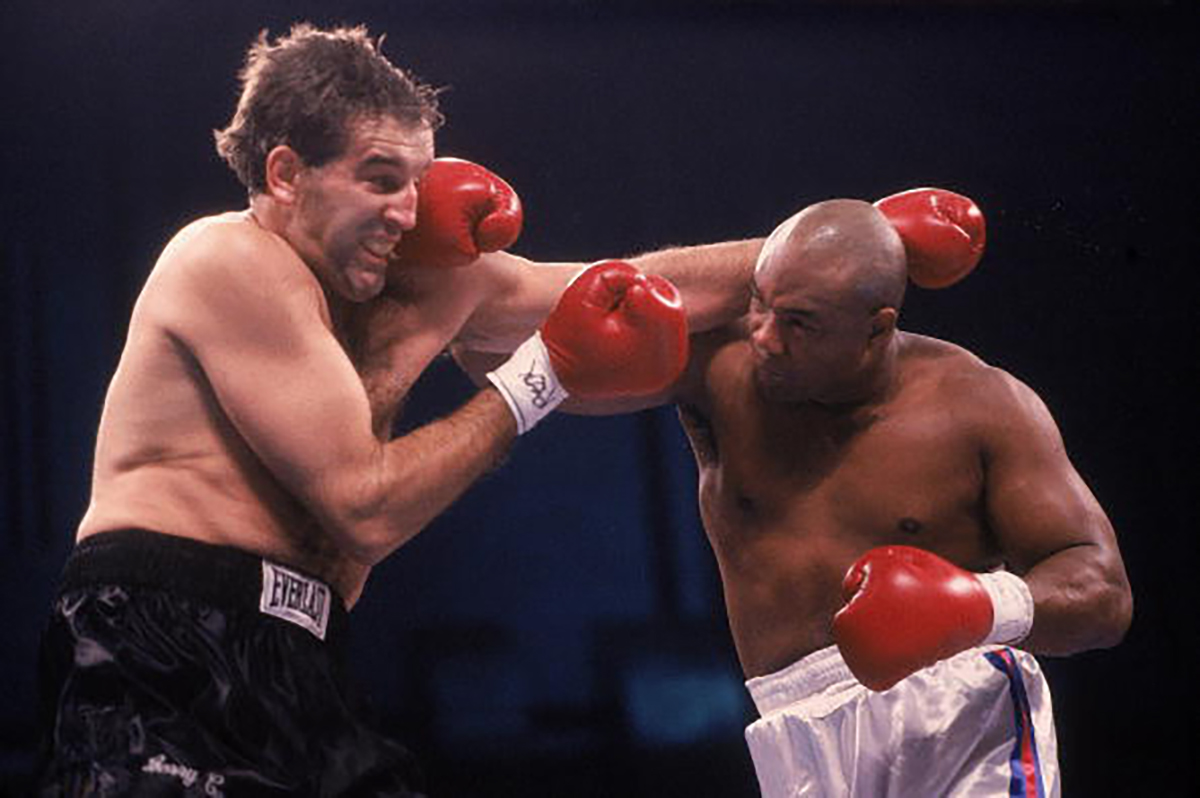At 38 years of age and no longer looking the part of the villain in a suspense movie, Big George Foreman would return to the ring in March 1987. In his final fight in 1977, Foreman weighed 229 pounds. Fast forward a decade, and Big George was certainly bigger at 267 pounds, but could he be better?
Gone was the full head of hair, now replaced by a shiny bald dome. The lean yet powerful physique that had added to his menacing presence in the ’70s superseded with a heavier, rounder shape and a spare tire to replace the washboard stomach of the former champion.
Don King had been Foreman’s promoter for the majority of his first career. Now Bob Arum and his company, Top Rank Boxing, would orchestrate his return to boxing, which started with a fourth-round knockout of journeyman Steve Zouski.
Second of three parts. Read Part One here.
New Look For The Returning Veteran
Big George was never known for his speed in his prime, but this version of Foreman was a much slower replacement. The power was still there, but his reflexes now dimmed in comparison as he was a bigger, slower target. There would be rust to shed, and his promotional team did a good job of removing that decay by keeping him active.
Foreman would have his second comeback fight four months later and score another early knockout, this time in round three. Two months later, Foreman delivered a sixth-round knockout of Bobby Crabtree, followed by two more fights and two more knockouts to close out 1987. Five fights into his impossible comeback, Foreman had registered five knockouts.
To the general public, Foreman was nothing more than a sideshow. A former champion far removed from his prime, milking his name for however much more money he could squeeze out of it. Sequentially, Foreman was taking matters very seriously with the dream of once again becoming heavyweight champion.
Foreman Passes His First Serious Comeback Test
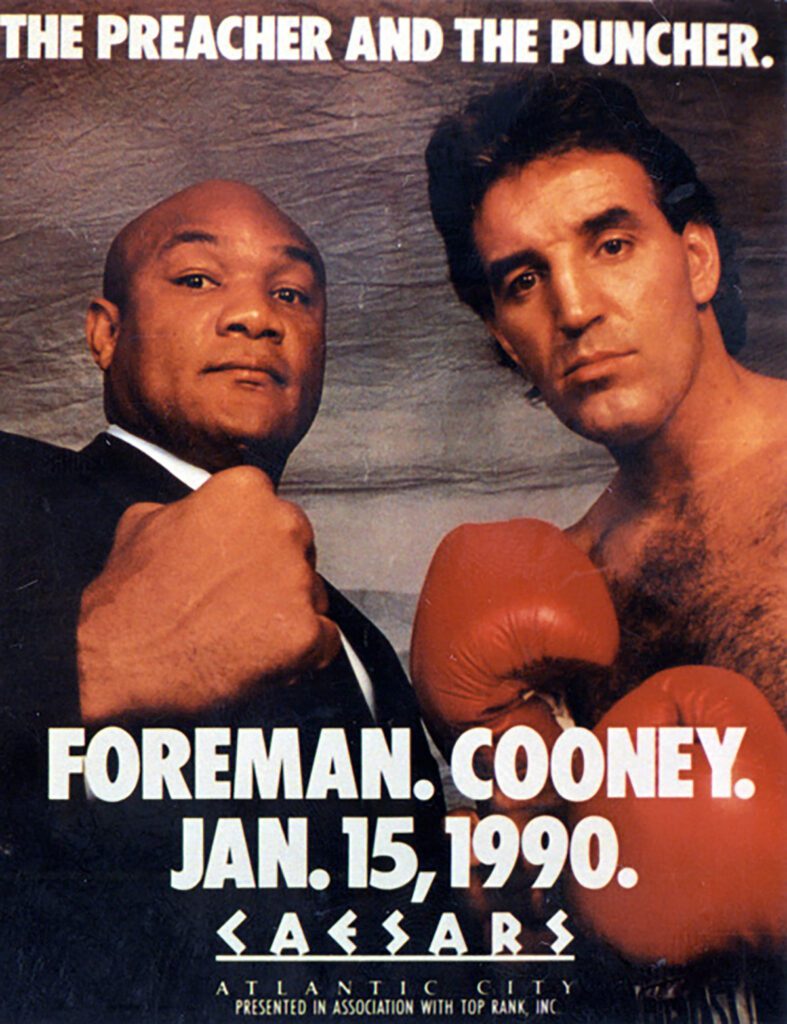
Two more early knockouts started Foreman’s 1988 campaign, both of the same journeyman caliber, making it seven wins all via stoppage for the comeback of Big George. Next came a bit of a step up fight against a formidable name in former two-time cruiserweight world champion Dwight Muhammad Qawi.
At 35 years of age, Qawi was only a year and a half removed from his title run, but that was in a weight class south of the giants. Qawi would prove to be too small for Big George, who would stop the former champion in seven rounds.
Another six fights all ending well before the final bell would close out a very effective 1988 for Foreman. Although Foreman was not beating contenders, what he was doing was exactly what he was supposed to do with fighters put in front of him, and that was to get rid of them and move on to the next.
Big George turned 40 in 1989, almost unheard of for an active fighter at the time. Foreman welcomed his 40s often, repeating that “age is just a number” and that 40 “wasn’t a death sentence,” which he continued to prove by going 5-0 with four knockouts to close out the 1980s.
Thus far, George Foreman’s comeback through 14 fights has produced 14 victories, with all but one coming by stoppage. He was fighting regularly on TV and beginning to garner interest from the public, many of whom found his journey both inspirational and worth rooting for.
Foreman vs Cooney Proves Big George Is For Real
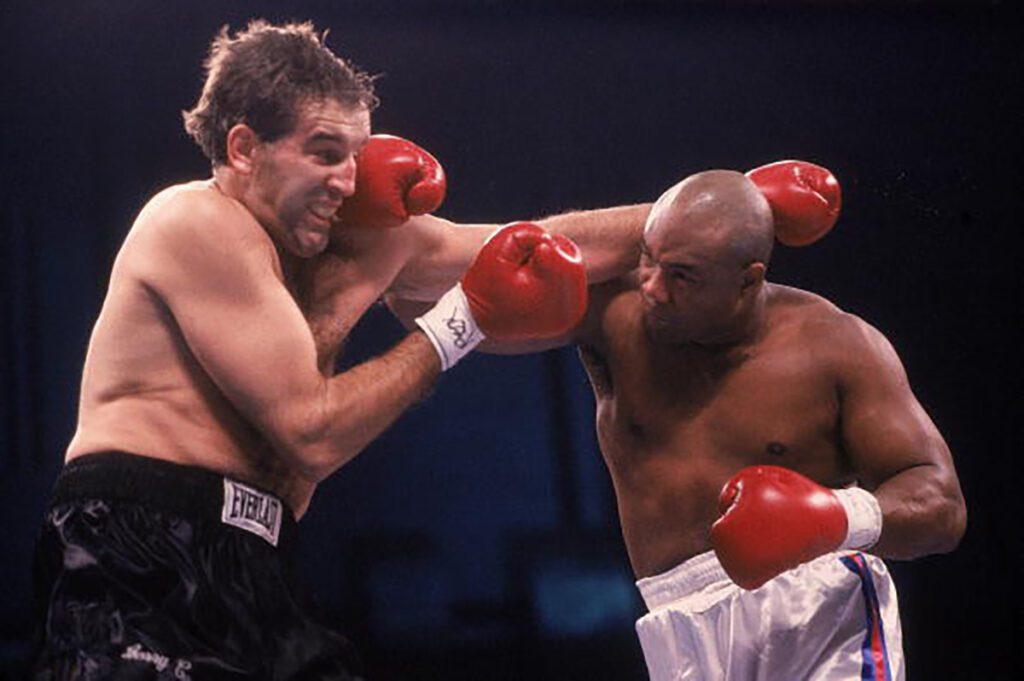
If Foreman was not yet considered a viable heavyweight contender, he was establishing himself as a box office attraction, and in 1990, Big George would headline his first pay-per-view fight of his comeback. He would face Gerry Cooney at the Convention Center in Atlantic City.
Foreman and Cooney (a big attraction in the early 80s in his own right) would each receive one million dollars for their services. A crowd of nearly 13,000 would see Foreman make a statement with a two-round destruction of Cooney.
A week later, Foreman was making the rounds, appearing as a guest on “The David Letterman Show” to talk about his recent triumph, making it clear he returned to win the heavyweight championship. He proclaimed he wanted to fight Mike Tyson. Four more victories, all by knockout, would close out the third full year of George’s second act.
Early in 1990, Tyson lost the heavyweight championship to Buster Douglas, who in turn would be knocked out in three rounds by Evander Holyfield later that year. Holyfield looked to establish himself as a box office attraction and needed a dance partner who would gain public interest.
Holyfield vs Foreman: Closer Result Than Expected
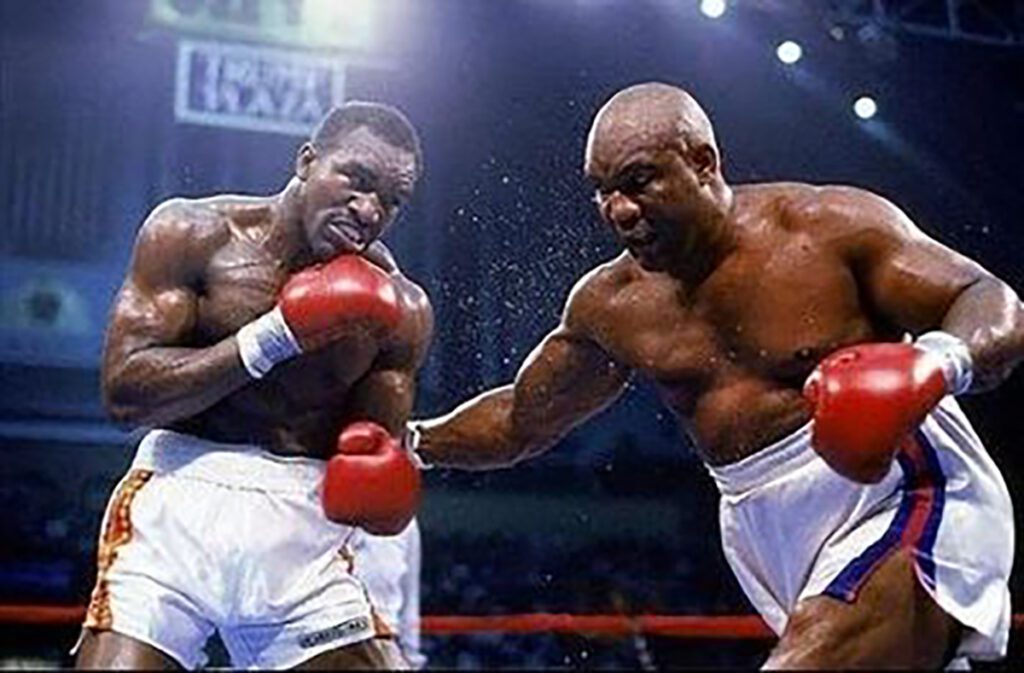
Insert George Foreman. Forty-two years old, four years and 24 wins into his comeback, Foreman would get a shot at the title against the 28-year-old Holyfield in a fight billed “The Battle Of The Ages.” The fight would take place at the Atlantic City Convention Center.
Going into the bout, the general consensus was that the 42-year-old Foreman had no business at his advanced age taking on such a well-respected, undefeated champion and that the old man wouldn’t last long. The pay-per-view drew 1.45 million buys, with another 17,000-plus in attendance. Holyfield was paid $20 million for his title defense; Foreman got a career high $12.5 million, which was more than enough to wipe away concerns about the future of his church and youth center.
What was predicted to be a one-sided affair proved anything but as Foreman gave Holyfield all he could handle over the course of 12 rounds. Foreman managed to stun the champion in several rounds, notably in round seven. Holyfield returned the favor in that very same round, and it looked at one point like the big man was ready to go after absorbing a furious 15-second combination of clean punches from the champion, but Foreman weathered the storm.
When it was all said and done, Holyfield was the victor by a wide margin on the scorecards, a margin that did not reflect how competitive the fight was. Big George would have to go back to the drawing board but gained more credibility in defeat than in all 24 previous comeback fights combined. He would gain a new job in the broadcast booth, commentating for HBO Sports, calling the action from the ringside.
New Attitude in Foreman’s Second Act
Foreman returned to the ring late in the year for a second fight in 1991, as the super busy schedule he maintained the first four years of his comeback was set aside for his lucrative broadcasting deal with HBO. He knocked out undefeated Jimmy Ellis in December and then returned four months later, eking out a very close and hard-fought victory over the big punching Alex Stewart in his only outing of 1992.
“Big George” would return nine months later against Pierre Coetzer and drop the South African twice over the course of eight one-sided rounds to earn another stoppage victory.
It was around this time Foreman began his relationship with Meineke mufflers as a spokesperson appearing in commercials, radio and print ads. The previous year saw Foreman in guest roles in episodes of popular TV shows “Home Improvement” and “The Larry Sanders Show.”
Foreman’s fighting style changed from the wild, free swinging executioner of the 1970s to a more patient, systematic boxer who set up his big punches. His personality and public perception had dramatically changed as well. No longer the fierce bulldozer of his first career, who often intimidated opponents with just a look, while being distant and aloof from the media, this version of Foreman was a showman. Always smiling ear to ear and engaging with reporters and press alike.
The personality transformation made Foreman a far more marketable commodity. He had his own video game for Nintendo, “George Foreman’s KO Boxing,” and often found himself on magazine covers and as a guest on late night talk shows. As much as Big George was enjoying his celebrity outside of the ring the ultimate goal of the comeback was always a clear mission, the heavyweight championship.
Foreman’s Second Chance Dreams Dashed by Morrison
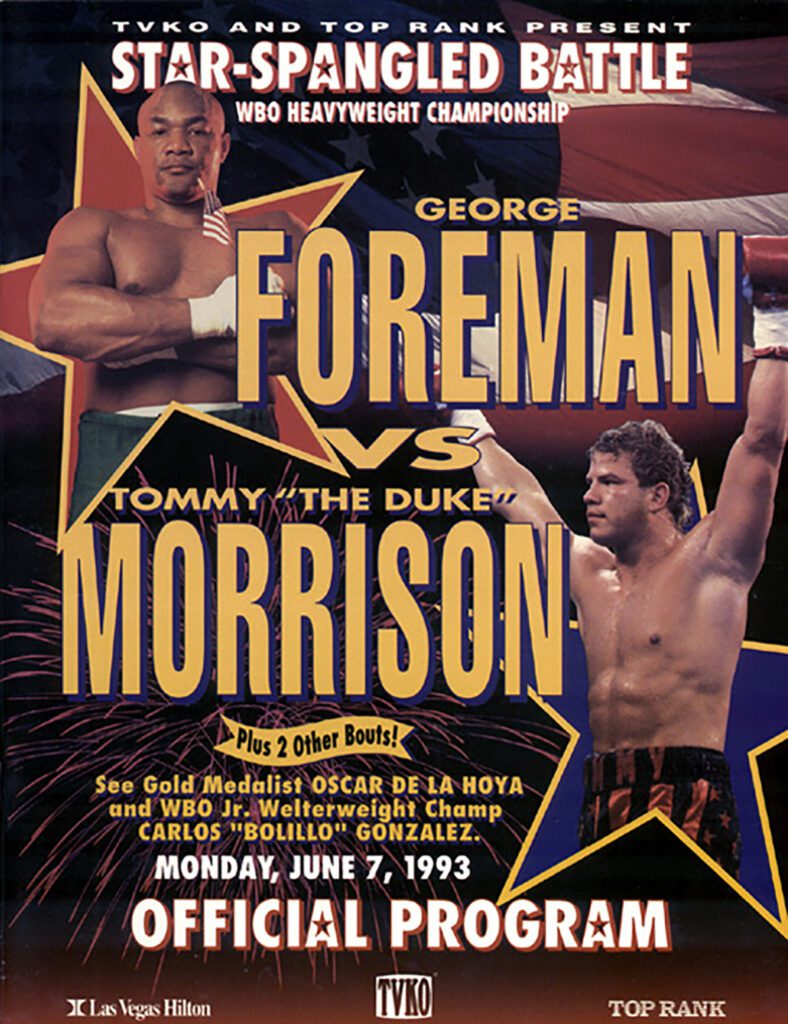
Foreman got his second chance at the prize in June 1993, this time for the newer and lesser respected but still recognized World Boxing Organization version of the title. The title was vacant, and a matchup between Foreman and Tommy “The Duke” Morrison was put together. It would take place in Las Vegas on pay-per-view and net Big George a $7 million payday.
Morrison sported a 36-1 record with 32 knockouts. Morrison was a big puncher known for his trademark left hook, which ended many an opponent’s night. He also had good handspeed for a heavyweight, which could be troubling for the older, heavier, and slower version of Big George.
Morrison had never been the full 12-round distance. He had never been 10 rounds before, as a great majority of his fights ended early, and he had only been past the sixth round twice. Both men possessed great power, but it was Foreman, at 44 years old and six years into his comeback, who had the proven gas tank, aided by his ability to fight in a relaxed manner. Heading into the fight, it was the one clear advantage for Foreman.
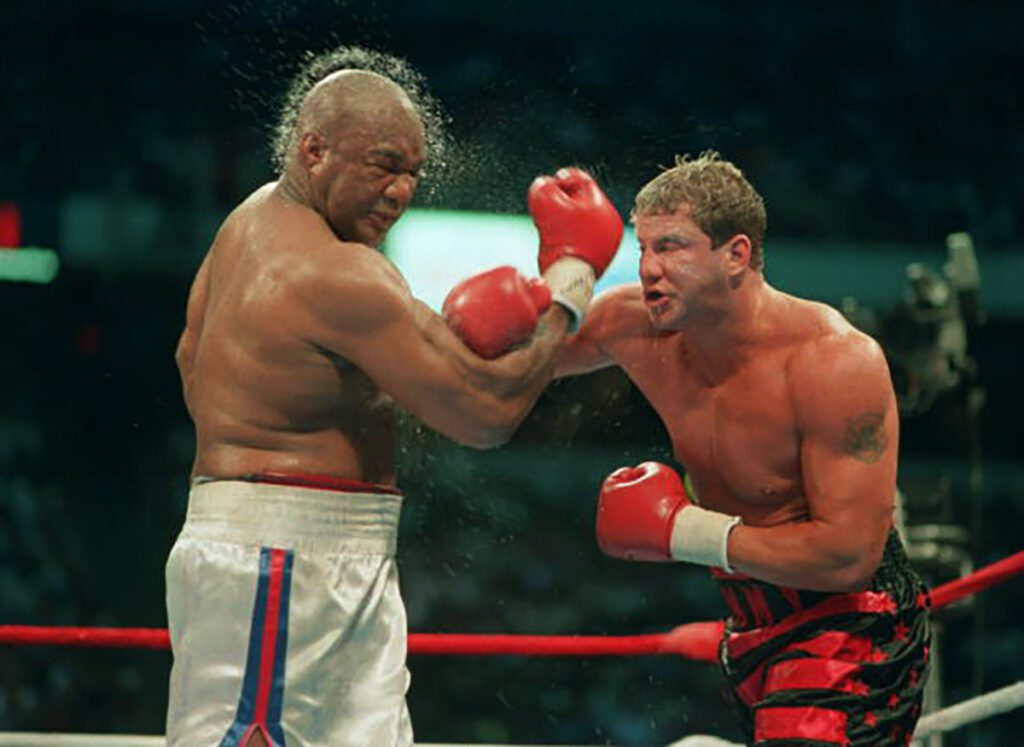
Oddsmakers had Big George as a seven-to-five favorite. His power, reliable chin, experience and stamina were thought to be too much for Morrison, who relied on sheer power and often fatigued in fights that lasted just a few rounds.
If that power couldn’t dent Foreman’s reliable chin, then it would seem a foregone conclusion that a battle of endurance would greatly favor Foreman.
What would end up happening was the least likely outcome. Morrison’s vaulted power would not play a huge role in the bout. Foreman’s incredible punch resistance was able to stand up to the many Morrison bombs he absorbed. Foreman looked slower than at any previous point of his comeback, and the speed advantage Morrison enjoyed, incorporated with a hit-and-move type offering, gave Foreman fits.
The Duke refused to stand in front of Foreman and fought on his terms, getting off quick combinations which often finished with a stiff jab before darting out of harm’s way. Morrison was weary as the rounds progressed, but not exhausted.
Foreman was never able to sustain long enough attacks to properly wear The Duke down to the point that he would have to stand still. Those were the opportunities that Foreman needed. Morrison would not cooperate.
Morrison won a unanimous 12-round decision to claim the world title. It was now looking like the impossible dream of Foreman was all but over.
